
Pinus aristata, the Rocky Mountain bristlecone pine or Colorado bristlecone pine is a long-lived species of bristlecone pine tree native to the United States. It is found in the Rocky Mountains in Colorado and northern New Mexico, with an isolated population in the San Francisco Peaks of Arizona. It is found at very high altitudes, from 2,100 to 4,000 meters in cold, dry subalpine climate conditions, often at the tree line, although it also forms extensive closed-canopy stands at somewhat lower elevations.
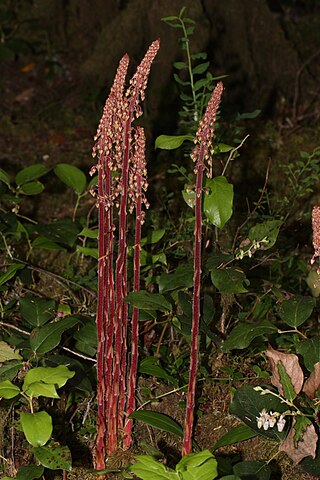
Pterospora, commonly known as pinedrops, woodland pinedrops, Albany beechdrops, or giant bird's nest, is a North American genus in the subfamily Monotropoideae of the heath family, and includes only the species Pterospora andromedea. It grows as a mycoheterotroph in coniferous or mixed forests. It is widespread across much of Canada as well as the western and northeastern United States to Mexico. Along with Monotropa it is one of the more frequently encountered genera of the Monotropoideae.
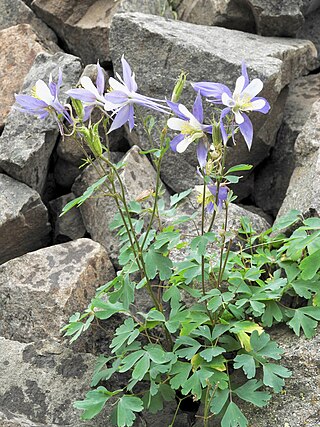
Aquilegia coerulea, the Colorado columbine, Rocky Mountain columbine, or blue columbine, is a species of flowering plant in the buttercup family Ranunculaceae, native to the Rocky Mountains and some of the surrounding states of the western United States. It is the state flower of Colorado. The Latin specific name coerulea means "sky blue".

Berberis repens commonly known as creeping mahonia, creeping grape holly, or creeping barberry, is a species of Berberis native to most of the western United States and two western provinces of Canada. It is low growing shrub that spreads by underground stems. As a species it is well adapted to fire and is a very common understory plant in western forests. An evergreen species, it provides food to deer and elk in winter and can make up a significant part of their diet. The berries are eaten by birds and small mammals, aiding it in spreading to recently disturbed areas. It has found use as a xeric ornamental plant and has escaped from cultivation in areas beyond its native range.

Zeltnera exaltata is a species of flowering plant in the gentian family known by the common names desert centaury and tall centaury. It is native to much of western North America from British Columbia to Arizona to Nebraska, where it grows in moist areas, generally with alkaline soils. This is an annual herb which is variable in appearance, especially in different habitat types. It grows up to about 35 centimeters in height, its slender stem with widely spaced pairs of oppositely arranged, pointed leaves 1 to 3 centimeters long. The inflorescence is an open array of flowers, each on a pedicel which may be several centimeters in length. The flower has generally four or five white or pink lobes, each somewhat rolled to appear narrow in shape.

Quercus turbinella is a North American species of oak known by the common names shruboak, turbinella oak, shrub live oak, and gray oak. It is native to Arizona, California, New Mexico, Utah, Colorado, and Nevada in the western United States. It also occurs in northern Mexico.
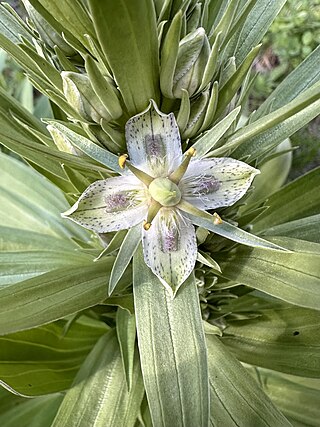
Frasera speciosa is a species of flowering plant in the gentian family (Gentianaceae) known by the common names elkweed, monument plant, and green gentian. When blooming it grows a tall stalk with numerous flowers that have purple dotted green petals. Each plant can flower just once before it dies.
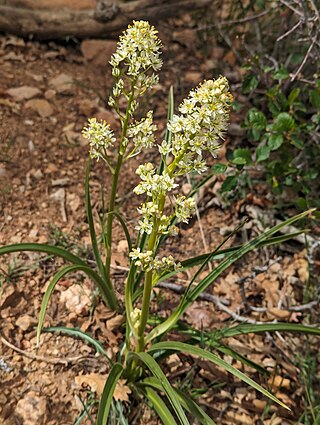
Toxicoscordion paniculatum is a species of flowering plant known by the common names foothill deathcamas, panicled death-camas, and sand-corn. It is widely distributed across much of the western United States, especially in the mountains and deserts of the Great Basin region west of the Rocky Mountains. It grows in many types of habitats, including sagebrush plateau, grasslands, forests, and woodlands.

Tetraneuris acaulis is a North American species of flowering plants in the sunflower family. It is known by many common names in English including stemless four-nerve daisy, stemless hymenoxys, butte marigold, and stemless rubberweed.
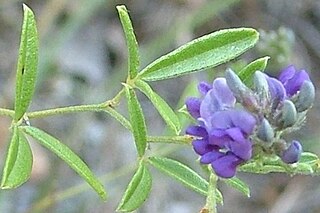
Pediomelum tenuiflorum, the slimflower scurfpea, is a perennial in the pea family. It is about 2–3 feet (0.6–0.9 m) tall and has a lot of leaves on top. Its leaves can reach a length of 3 inches (80 mm). This flower can be found mainly in the central and southwestern U.S.
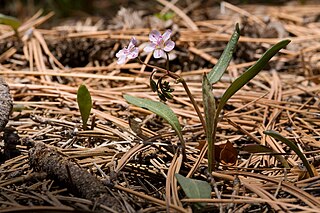
Claytonia rosea, commonly called Rocky Mountain spring beauty, western springbeauty or Madrean springbeauty, is a diminutive spring blooming ephemeral plant with pale pink to magenta flowers. It grows a small round tuberous root and it one of the earliest wildflowers of spring in its range. It is found in dry meadows in forests of ponderosa and Chihuahuan pines, and moist ledges of mountain slopes of the Beaver Dam Mountains of Utah, Colorado Front Range, and Sierra Madre Occidental, south and east to the Sierra Maderas del Carmen of Coahuila.

Mertensia lanceolata, known as prairie bluebells, lance-leaved bluebells, lance-leaved lungwort, and narrow-leaved languid ladies is a species of flowering plant native to the Rocky Mountains and areas of the northern Great Plains in western North America. A herbaceous perennial it has blue-green leaves alternately arranged on its smooth flowering stalk. Its flower buds are pink-purple and become blue as they open.

Castilleja rhexiifolia, commonly called rosy paintbrush, subalpine paintbrush, or rhexia-leaved paintbrush, is a species of plant in Orobanchaceae, commonly known as the broomrape family. They are a common flower found in moist habitats near or above timberline in the Rocky Mountains and the Pacific Northwest. Like most members of the Castilleja genus, they are partially parasitic plants.
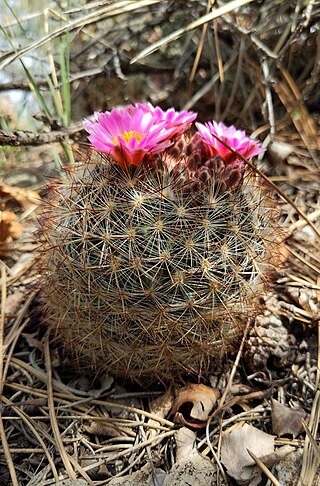
Pediocactus simpsonii, known by the common names mountain cactus, snowball cactus, and mountain ball cactus, is a relatively common cactus that has adapted to survive in cold and dry environments in high elevation areas of the western United States. It can be found at higher elevations than any other cactus in North America. While not a landscape dominating plant, it is a relatively common species and the most common member of the genus Pediocactus. Because of its beauty and adaptation to cold environments it is sometimes grown by gardeners in areas that have few other choices due to the limited number of cactuses with cold adaptations. Like many cactuses its populations are sometimes threatened by this desirability due to the theft or removal of plants from the wild by collectors.

Townsendia grandiflora, commonly called largeflower ground-daisy, largeflower townsendia, or showy townsendia is an inconspcious plant of the foothills of the Rocky Mountains and nearby shortgrass prairies. They are usually found in somewhat eroded or rocky areas such as the sides of hills, banks, and mesas. They are part of the Townsendia genus, which can be difficult for both amateur and expert botanists to correctly identify. A short-lived plant, they are nonetheless grown by rock garden enthusiasts for their relatively large daisy-like flowers.

Noccaea fendleri more commonly known as wild candytuft and alpine pennycress is a wildflower in the mustard family from western North America. It grows in mountains from northern Mexico to the northern United States. It blooms early in the spring and provides nectar to butterflies.
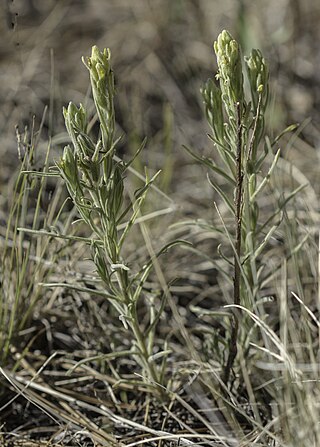
Castilleja lineata, commonly known as marshmeadow paintbrush or linearlobe paintbrush, is an uncommon species that largely grows in the mountains of northern New Mexico, but is also found in small areas of neighboring Colorado and Arizona. It was not scientifically described until 1901 and is little studied.

Castilleja haydenii, also known as Hayden's paintbrush, is a species of flower found in the mountains of southern Colorado and northern New Mexico, generally above timberline in the alpine tundra. Its purple flowers appear in the months of July through September. It was named after the geologist Ferdinand Vandeveer Hayden.
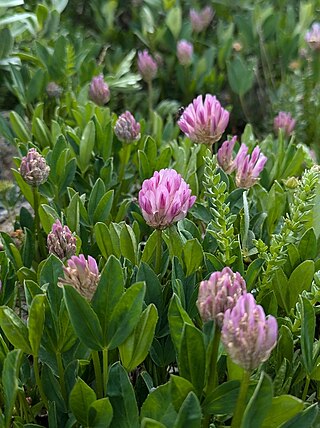
Trifolium parryi, commonly known as Parry's clover or Parry clover, is a high altitude species of plant from the western United States. It grows in the Rocky Mountains from southern Montana to northern New Mexico. It is a short plant that is adapted to the harsh conditions and short growing season near and above timberline.

Sphaeralcea parvifolia, commonly called small-leaved globe-mallow or small-leaf globemallow, is a species of plant native to the western United States in the Great Basin and Colorado River drainage. It is medium sized herbaceous species that has showy orange flower spikes. It is used in wildflower and dry gardens.





















